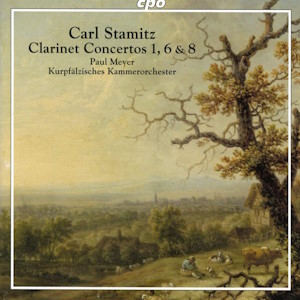
Carl Stamitz (1745-1801)
Concertos for Clarinet and Orchestra Volume 2
Clarinet Concerto No. 1 in F major
Clarinet Concerto No. 6 in E flat Major
Clarinet Concerto No. 8 in B flat major
Kurpfälzisches Kammerorchester/ Paul Meyer (clarinet)
rec. 2020, Epiphaniaskirche, Mannheim, Freudenhem, Germany
cpo 555 415-2 [51]
Born in Mannheim as the eldest son of violinist and composer Johann Wenzel Stamitz, Carl Stamitz spent most of the time between 1770 and 1794 travelling as a virtuoso on the violin, viola, and viola d’amore. His compositions include more than fifty symphonies and over sixty concertos for various instruments. The dates of the three clarinet concertos on the present disc are obscure, and the one in E-flat may have been a collaboration between Stamitz and the clarinet virtuoso Joseph Beer because both of their names are on the title page of the manuscript.
‘Carl Stamitz – Concertos for Clarinet and Orchestra, volume 2’, will appeal to listeners who want to learn about a key composer who emerged from Mannheim, a centre of musical innovation during the eighteenth century. The Mannheimer Hofkapelle, one of the finest orchestras in Europe, exerted enormous influence on the development of music. Wolfgang Amadé Mozart, who visited the city four times, including a sojourn from November 1777 to March 1778, esteemed this ensemble.
The booklet that accompanies the CD contains a quotation from a letter to Leopold Mozart, dated 9 July 1778, in which Johann and Carl Stamitz are described as ‘2 Elende Notenschmierer’ (i.e., miserable music daubers). Since the concertos on this disc are my first encounter with Stamitz’s music, I will refrain from concurring with Mozart’s judgement prima facie. Another contemporary critic, Christian Friedrich Daniel Schubart, is cited in the booklet as likening Stamitz’s rondeau movements to ‘Venus’s kisses dipped in honey’.
In my opinion, these three clarinet concertos demonstrate a high level of compositional skill and insight into the potential of the then-relatively-new woodwind instrument. Each concerto consists of three movements: an opening Allegro followed by an Andante moderato (Concerto No. 1), a Siciliano con espressione (Concerto No. 6), or an Adagio (Concerto No. 8), and a concluding Rondeau.Stamitz’s material is beautiful in a decorative sense, which is ideal for background music in a royal court. For all their refinement, these works have little drama or forward momentum.
Paul Meyer directs the Kurpfälzisches Kammerorchester with élan in performances that make the best possible case for this music, particularly the intricate clarinet runs in the Rondeau finales. Meyer plays the technically demanding clarinet parts with passion and seemingly effortless mastery. This recording is a substantial contribution to the discography not only of Stamitz, but of lesser-known music composed concurrently with works by Mozart and Franz Joseph Haydn.
CPO’s presentation sets a standard that major record companies should follow. The CD is in a jewel case; the booklet features a high-quality reproduction of Christian Georg Schütz’s painting ‘Landscape with animals in the pasture’ (1817) and an informative essay in German and English. The recorded sound is crisp, clear, and detailed throughout. Anyone interested in discovering music by a member of the ‘Mannheimer Schule’ should not hesitate to acquire this disc.
Daniel Floyd
Previous review: Gary Higginson (June 2023)
Help us financially by purchasing from




















